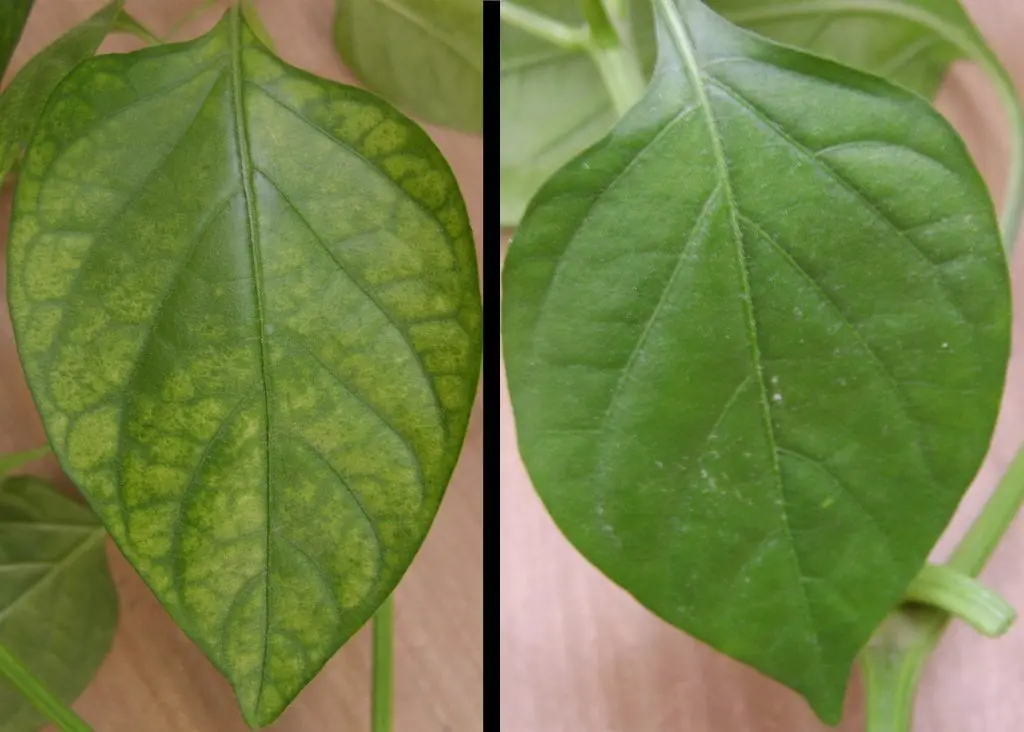Plants, to look healthy, need to absorb a number of nutrients. When some are not available, some other problems can arise. To avoid this, I am going to tell you how you can identify the lack of nutrients in plants .
So you can have great pots and a garden.
Index
- 1 What nutrients do they need?
- 2 What nutrients is my garden soil lacking?
- 3 What are the symptoms of lack of nutrients in plants?
- 4 What to do?
- 5 Tips
- 5.1 Check the pH of the water
- 5.2 Do not remove the yellow leaves
- 5.3 Pay regularly
What nutrients do they need?

All living things need above all 13, which are divided into macronutrients and micronutrients . Of course, each plant and each animal absorbs them to a greater or lesser extent depending on their needs, but they are all equally important.
The macronutrients are:
- Nitrogen (N): helps to synthesize chlorophyll, so it plays a very important role in photosynthesis.
- Phosphorus (P): it is important for growth, favoring root development.
- Potassium (K): promotes the development and growth of flowers and fruits, regulates photosynthesis and gives resistance to plants.
- Calcium (Ca): promotes cell growth, and protects the plant against diseases.
- Magnesium (Mg): it is essential so that it can carry out photosynthesis.
- Sulfur (S): is important for the formation of chlorophyll.
And the micronutrients are:
- Iron (Fe): involved in plant growth.
- Zinc (Zn): converts starches into sugars (plant food), and helps them resist low temperatures.
- Chlorine (Cl): has an activity linked to photosynthesis.
- Manganese (Mn): plays an essential role in respiration, photosynthesis and nitrogen assimilation.
- Copper (Cu): it is necessary in the process of photosynthesis, in plant respiration, and also helps to metabolize carbohydrates and proteins.
- Molybdenum (Mo): Converts nitrate to nitrite (which is a toxic form of nitrogen), and then to ammonia, then uses it to synthesize amino acids.
- Boron (B): is essential for cell division, and, together with calcium, is involved in the synthesis of cell walls.
But not all the nutrients are available in all soils. Let’s see what are the nutrient deficiencies of each type.
What nutrients is my garden soil lacking?

Depending on the pH you have, you will lack one or the other, which are:
- Alkaline soil (pH greater than 7): iron, zinc, phosphorus, manganese, copper and boron.
- Neutral soil (pH between 6.5 and 7): they have all the necessary nutrients, so there are usually no problems.
- Acid soil (pH less than 6.5): magnesium, calcium, phosphorus, boron and molybdenum. Also, if it is very acid there may be excess zinc, iron and manganese.
What are the symptoms of lack of nutrients in plants?

It will depend on the nutrient in question, so we are going to see separately what happens to them if they lack one:
- Calcium – New leaves grow misshapen.
- Iron : the new leaves are yellow, with very green nerves.
- Phosphorus – Leaves turn a very dark green color. If the problem persists, they will turn red until they fall off.
- Magnesium – Lower leaves turn yellow from the edge inwards.
- Manganese : yellow spots near the nerves of the leaves.
- Nitrogen : the leaves lose their green color. The upper ones are light green, the lower ones yellow and the old ones turn brown until they fall.
- Potassium : the tips of the leaves turn yellow, and end up drying.
To do?

If your plant is lacking in nutrients and you have already identified which ones, it is time to help it recover as soon as possible. To do this, you must:
- Sulphur : pay with earthworm humus.
- Calcium : add chopped eggshells.
- Phosphorus : pay with guano.
- Iron : add iron sulfate to the soil, a small spoonful (of coffee). You can also use a specific fertilizer for acidophilic plants.
- Magnesium : you can add a small teaspoon (of the brown ones) of hydrated magnesium sulfate to 5 liters of water.
- Nitrogen : you can fertilize with an algae extract fertilizer or with earthworm humus.
- Potassium : pay with fertilizers rich in potassium, such as those for cacti.
Tips
Check the pH of the water

To prevent your plants from lacking nutrients, it is important that you grow them in a substrate or soil whose pH is suitable for the species in question. As we have seen, neutral soil is the most recommended for most of them, since practically all the nutrients are available; however, it is not enough to choose a good soil, it is very important to irrigate with the correct water .
So, how to know what pH the irrigation water has? With a pH meter that you will find for sale at nurseries and garden stores. With this little gadget you will quickly know what level of pH it has, and you will be able to act accordingly. For example:
- If the water is too alkaline, dilute the liquid from half a lemon in 1l/water.
- If the water is too acidic, dilute a little baking soda in 1l of water. Go measuring so it doesn’t rise too much.
Don’t remove the yellow leaves
Even if they look bad and won’t turn green, it’s best to leave them as they will eventually fall off on their own . In addition, when removing them, fungi could enter through that wound that would further harm the plant.
fertilize regularly
The nutrients from the substrate are being absorbed by the roots, but there comes a time when they can no longer do so because they run out of them. So that this does not happen, it must be fertilized throughout the growing season (spring and summer), with specific fertilizers for it.
And with this we end. With these tips, you will surely have beautiful plants.

